Marc Tyler Nobleman's Blog, page 68
February 3, 2015
Two weeks at the American School of Bombay
As I’ve written before, school visits are as educational for the author as for the students.

From 1/19-29/15, I was a guest at the American School of Bombay, which is in Mumbai, which is what Bombay was renamed in 1995. I spoke twice to all students from 4th to 8th grade (first an assembly then a breakout session) and once to each grade from 9th to 12th; I also did a talk for parents and a six-hour writing workshop for about 30 kids who’d signed up. Yes, six hours. (With breaks.)




Mumbai is the wealthiest city in India, though most streets I saw presented (often distressing) contradictions.
This was the farthest from home I’d ever been (7,978 miles), beating the previous record set by Tanzania a year ago the same month by only 62 miles. This was the closest my hotel has been to a school—literally next door.
The hotel was comfortable and had some quirks and perks:
the option of having four pieces of laundry cleaned per daythe most slippery floor of any hotel room I’ve stayed in (don’t know why)the thinnest rolls of toilet paper I’ve seen




In any city new to me, one of the first things I ask my hotel is where the nearest outdoor running track is. In this case, I needed only look out my hotel room window.

Bonus: an adjacent cricket and tennis court.
The following Saturday, the field was transformed for a grand wedding.
 5 p.m.
5 p.m.
 7 p.m.
7 p.m.
 9 p.m.
9 p.m.
 4 a.m.
4 a.m.
On my first of eight days speaking at the school, three students introduced my presentation. This culminated with one of them giving me a garland and another fingerpainting a tika (or bindi, though I understand that term is more commonly used with females) on my forehead, which I still had when I left the school that afternoon, by which time it had smeared into what looked more like a scab, which explains some of the looks I got walking back to the hotel.


The lower and upper schools are on different campuses, about a 20 minute ride. (If no traffic, it would take maybe six minutes.) Every hour during school hours, a van makes runs back and forth between the locations. On some days, I’d have to speak at one campus, then another, then back at the first. On one of the trips in the van, I had to sit in front—where there was no seat belt for the middle seat. Apparently, in India, it’s not standard to wear seat belts in the front seat. The streets are so choked that you cannot reach any significant speed, but still, I haven’t been in the front seat without a seat belt since…well, probably ever.
On my ride from the airport to the hotel, and several times after, I was amused to see a sign in an auto rickshaw (AKA tuk-tuk or three-wheeler) that read “Don’t Touch Me.” At first I thought it referred to the driver, but then realized it was always scrawled or attached to the meter, which is within reach of the passengers. Don’t tamper with your fare!
There is a movement to reduce the honking of car horns, but from where I sat, the movement has a long way to go. The noise of horns was constant. Some drivers who don’t mind paint “Horns OK Please” on their bumpers so other motorists don’t feel badly if they honk. (However, not displaying this charming permission did not hinder people from laying on the horn.)

When one of the campuses was put up, most of the area surrounding it was marshland. The building was designed to look somewhat like a hotel; if the school failed, they’d be ready for Plan B.
While in India, I was in touch with HarperCollins editor Jill Davis. To explain the odd hour my email was arriving, I said I was in India. I was surprised when she asked if I was at ASB, and even more surprised when she said she’d been here several years before. Her trip ended in an unthinkably tragic way. But she had happy memories, too. She sent me a photo of her with several students. The school helped me determine that three of those students were still at the school. We rounded them up and forced them to take a semi-reunion photo (which, unfortunately, the school policy does not allow me to post).
Throughout all this, my host was librarian Heeru Bhojwani. When asked, she shared her personal story, and, appropriately, Heeru is a hero.

This trip was a privilege and a dream. Thank you, Heeru and ASB, for giving me this gift.

From 1/19-29/15, I was a guest at the American School of Bombay, which is in Mumbai, which is what Bombay was renamed in 1995. I spoke twice to all students from 4th to 8th grade (first an assembly then a breakout session) and once to each grade from 9th to 12th; I also did a talk for parents and a six-hour writing workshop for about 30 kids who’d signed up. Yes, six hours. (With breaks.)




Mumbai is the wealthiest city in India, though most streets I saw presented (often distressing) contradictions.
This was the farthest from home I’d ever been (7,978 miles), beating the previous record set by Tanzania a year ago the same month by only 62 miles. This was the closest my hotel has been to a school—literally next door.
The hotel was comfortable and had some quirks and perks:
the option of having four pieces of laundry cleaned per daythe most slippery floor of any hotel room I’ve stayed in (don’t know why)the thinnest rolls of toilet paper I’ve seen




In any city new to me, one of the first things I ask my hotel is where the nearest outdoor running track is. In this case, I needed only look out my hotel room window.

Bonus: an adjacent cricket and tennis court.
The following Saturday, the field was transformed for a grand wedding.
 5 p.m.
5 p.m. 7 p.m.
7 p.m. 9 p.m.
9 p.m. 4 a.m.
4 a.m.On my first of eight days speaking at the school, three students introduced my presentation. This culminated with one of them giving me a garland and another fingerpainting a tika (or bindi, though I understand that term is more commonly used with females) on my forehead, which I still had when I left the school that afternoon, by which time it had smeared into what looked more like a scab, which explains some of the looks I got walking back to the hotel.


The lower and upper schools are on different campuses, about a 20 minute ride. (If no traffic, it would take maybe six minutes.) Every hour during school hours, a van makes runs back and forth between the locations. On some days, I’d have to speak at one campus, then another, then back at the first. On one of the trips in the van, I had to sit in front—where there was no seat belt for the middle seat. Apparently, in India, it’s not standard to wear seat belts in the front seat. The streets are so choked that you cannot reach any significant speed, but still, I haven’t been in the front seat without a seat belt since…well, probably ever.
On my ride from the airport to the hotel, and several times after, I was amused to see a sign in an auto rickshaw (AKA tuk-tuk or three-wheeler) that read “Don’t Touch Me.” At first I thought it referred to the driver, but then realized it was always scrawled or attached to the meter, which is within reach of the passengers. Don’t tamper with your fare!
There is a movement to reduce the honking of car horns, but from where I sat, the movement has a long way to go. The noise of horns was constant. Some drivers who don’t mind paint “Horns OK Please” on their bumpers so other motorists don’t feel badly if they honk. (However, not displaying this charming permission did not hinder people from laying on the horn.)

When one of the campuses was put up, most of the area surrounding it was marshland. The building was designed to look somewhat like a hotel; if the school failed, they’d be ready for Plan B.
While in India, I was in touch with HarperCollins editor Jill Davis. To explain the odd hour my email was arriving, I said I was in India. I was surprised when she asked if I was at ASB, and even more surprised when she said she’d been here several years before. Her trip ended in an unthinkably tragic way. But she had happy memories, too. She sent me a photo of her with several students. The school helped me determine that three of those students were still at the school. We rounded them up and forced them to take a semi-reunion photo (which, unfortunately, the school policy does not allow me to post).
Throughout all this, my host was librarian Heeru Bhojwani. When asked, she shared her personal story, and, appropriately, Heeru is a hero.

This trip was a privilege and a dream. Thank you, Heeru and ASB, for giving me this gift.
Published on February 03, 2015 04:00
February 1, 2015
The chupacabra vs. Johnny Depp
In my upcoming picture book The Chupacabra Ate the Candelabra, a group of goats confronts their greatest fear—the legendary chupacabra.
In Tokyo this past week, so did actor Johnny Depp.
That chupacabra was a long, long way from home.
In Tokyo this past week, so did actor Johnny Depp.
That chupacabra was a long, long way from home.
Published on February 01, 2015 04:00
January 20, 2015
“The Flash” (1990 TV show): short series, big impact
The freshman CW hit show The Flash has me reflecting more than usual on a show from the past.
My freshman year of college, I had a subscription to TV Guide but no TV. No matter, because there was only one show I wouldn’t miss: The Flash on CBS.
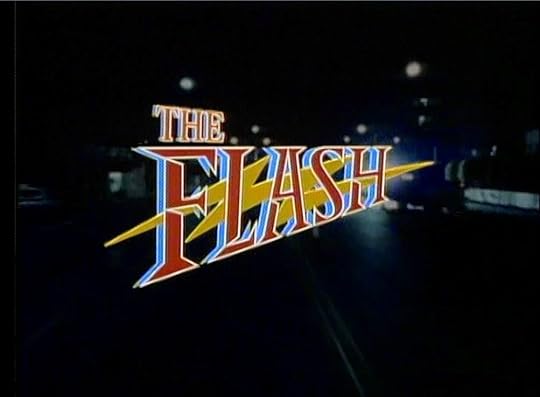
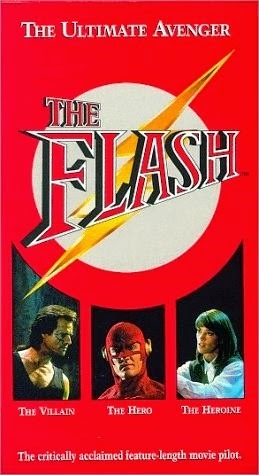
I remember finding it funny how TV Guide had to reword the marketing of its original ad when it reran the premiere:
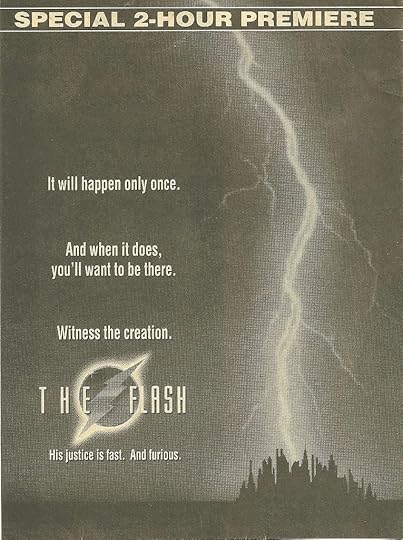
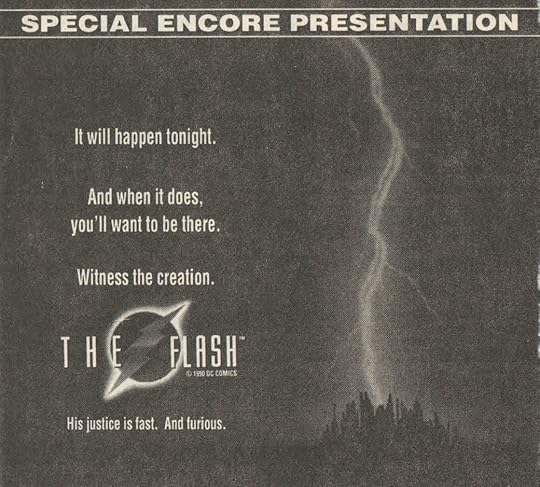
This was a year after Tim Burton’s juggernaut Batman, and its aesthetic was forced on the Flash, a character who had never been grim—in fact quite the opposite. So the show struck a divided tone—gritty, often dark Flash sequences, cheeky and at times cheesy Barry Allen scenes. (Part of the cheese was simply a symptom of the times—it was the fashion era of baggy pants. Please Allen, don’t hurt ‘em.)
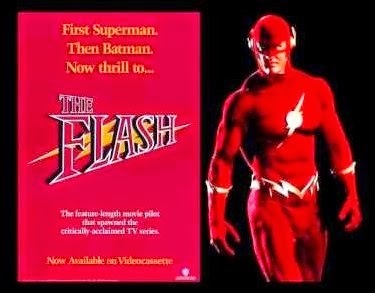
I loved how the Flash pilot copied Batman with a scene in which something (the Batwing in Batman, a bolt of lightning in Flash) turned the moon into the emblem of the title hero:
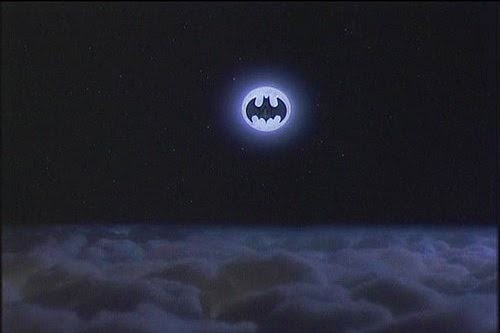
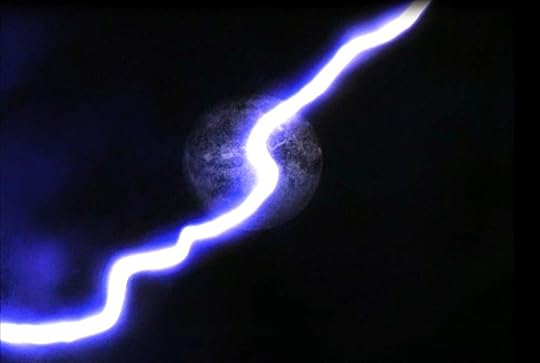
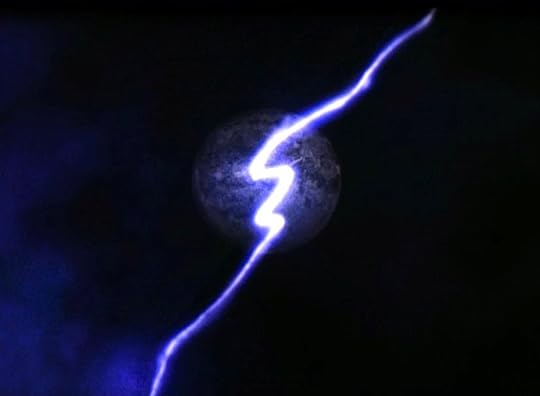
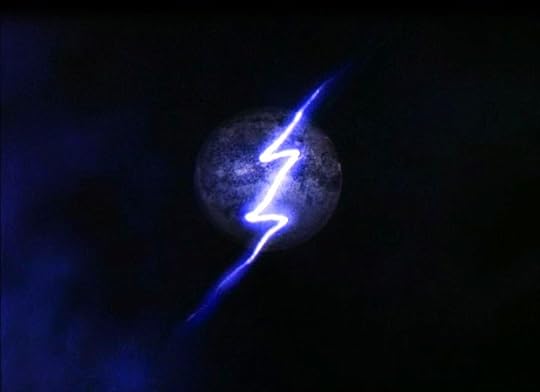
The show was canceled after one season, though the factors were cost and competition more than quality...this TV Guide review aside:
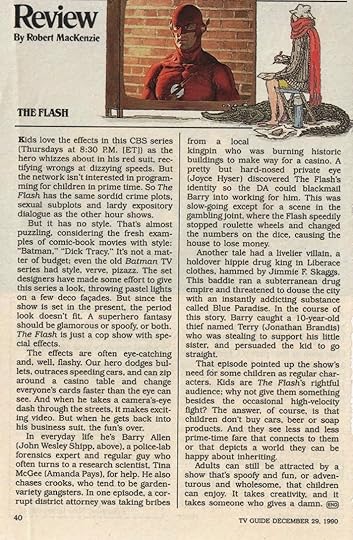
My commitment to this show began with a commitment to the character who, as it happens, had “died” five years earlier. In the landmark 1985 comic book maxi-series Crisis on Infinite Earths, Barry Allen nobly sacrificed himself to save multiple worlds. In comics, deaths are typically temporary, but this one would last a notable 23 years.
So in 1990, Barry Allen was a memory in print but a, well, flash of fresh air on TV. He was the first live-action DC hero whose show felt like a movie rather than a TV show (see Superboy, Wonder Woman, Batman).
It turned out that the original pitch for the show that became The Flash was called Unlimited Powers and featured four heroes. It would have been an eclectic assortment with no comic book precedent: the Flash, Green Arrow’s daughter, Dr. Occult, and Blok (from the Legion of Super-Heroes). Deemed too expensive if not too odd, the Flash (as he does) broke away from the pack and the other three characters were ditched.
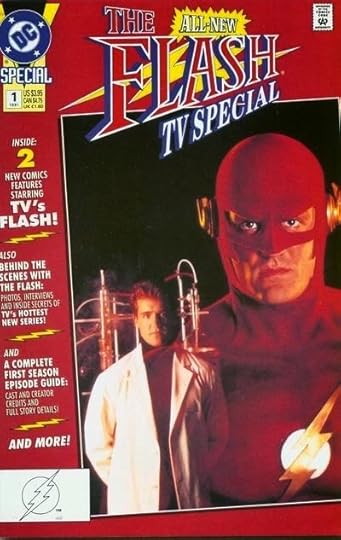
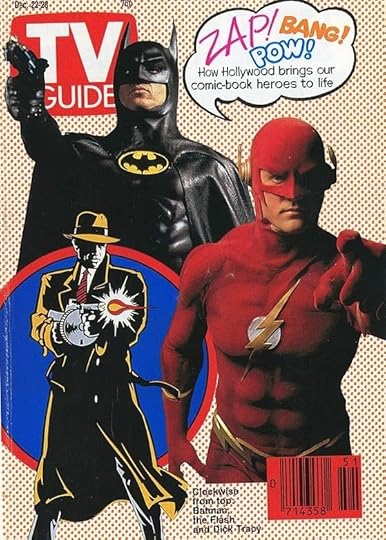
It was a thrill when, in 2009, I reached out to its star, John Wesley Shipp, on Facebook, and he reached back. He seems every bit as cool in real life as his character was on the show.
The Flash, for all intents, was a two-actor show: Shipp and Amanda Pays as scientist/friend/guide/inevitable love interest Tina McGee. A third actor, Alex Desert, was included in the opening credits, and others (mostly cops) recurred in small roles, but most of the show revolved around Barry and Tina. (A 2009 interview with both actors at a con—the first one Pays attended.) In the current TV incarnation of the Flash, his behind-the-scenes team (Harrison Wells, Caitlin Snow, and Cisco Ramon) alone is bigger than that. Castwise, The Flash ‘90 seems so simple in our era of shows with, commonly, at least six regulars who appear roughly equally.
Flash ‘90 is the first filmed DC entertainment with an “Oracle” figure. Oracle herself (Barbara Gordon as information broker/Big Sister Is Watching, after the Joker crippled her in a 1988 story) debuted in 1989, a year before The Flash. Tina was that show’s Oracle, and a variation of her has since appeared in Smallville (Chloe Sullivan), Arrow (Felicity Smoak), and Flash ‘14 (Caitlin Show). All are tech guru-esses, all have some degree of romantic chemistry with the lead hero.
Tina McGee made her debut appearance on Flash ‘14 in the “mid-season finale” (a transparently manipulative term/concept that, of course, didn’t exist in 1990). This was especially interesting because Tina was again played by Amanda Pays—but it was not the same Tina from the previous show. It couldn’t be—she knew Barry Allen, and Grant Gustin is no John Wesley Shipp. (I mean that literally—not as a dig.)
Is this the first instance of the same actor portraying two versions of the same character? It’s definitely the first instance of one actor portraying a character of the same name on two separate shows of the same name…followed closely by Mark Hamill as the Trickster, which was announced 12/8/14, the day before the mid-season finale. (The day after would have made more sense to me.)
Flash ‘90 was an attempt—now ubiquitous—to do filmed superheroes “realistically.” A prime example: no spandex. The way the show explained why Barry wore a costume—and where the costume came from—both struck me as pretty close to realistic, or at least believable. He wore a costume (and specifically requested that it have a mask and gloves) to protect his identity when seeking revenge—or justice—for the murder of his brother. The costume was a prototype developed for cosmonauts (red, get it?), designed to withstand pressure and friction.
While most everyone is binge-watching critically acclaimed contemporary shows such as Homeland, Game of Thrones, and Orange Is the New Black, I’m reverse-flashing to Maroon Is the New Red.
Episode-specific observations (some I recalled from original viewing, some new):
“Watching the Detectives” features a cameo by Frankie Thorn, whom I interviewed for her appearance in the “We Didn’t Start the Fire” video by Billy Joel, though at the time, I did not know/remember she had been in that Flash episode. (See below for a similar discovery in “Done With Mirrors.”)
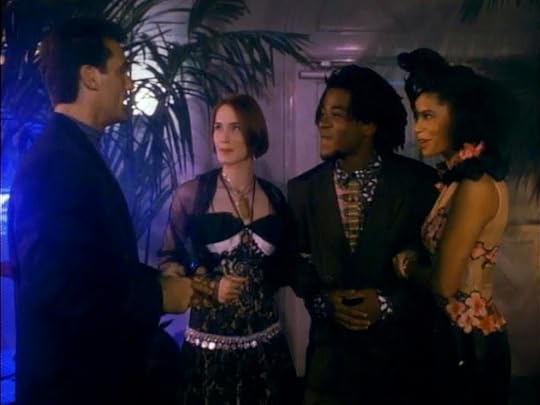
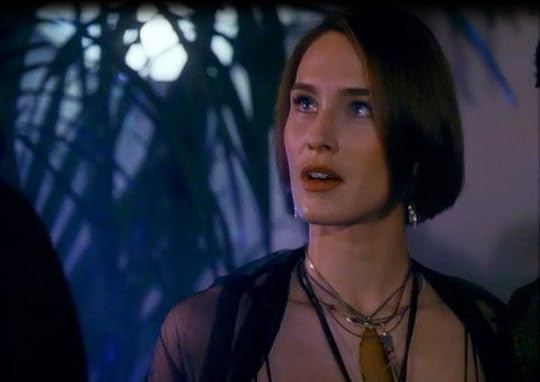
In the same episode, Tina name-drops Carter Hall…AKA Hawkman. As far as I know, that was the only time, and he never appeared in the flesh.
Also in the same episode is what might be my all-time favorite scene from the series, in which a crooked DA, who used a shady method to learn the Flash’s secret identity, tries to bribe Barry. When Barry plays dumb, the DA threatens him with an armed grenade. The DA says “In your short career, you’ve already made enemies in all the wrong places, Barry. If your identity was made public, everyone you love would be in danger from everything in Central City. Your family, your friends, your dog…here boy! Fetch! Four-second fuse. Three…two…”
I don’t believe the scene is on YouTube so here are screenshots showing how Barry let go of a glass, flashed to the grenade, reinserted the pin (which, I believe, would not really stop the grenade from exploding), set the grenade on his desk, and caught the glass, which had fallen only an inch or two:
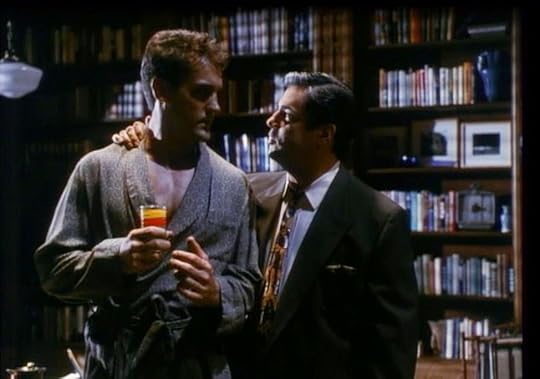
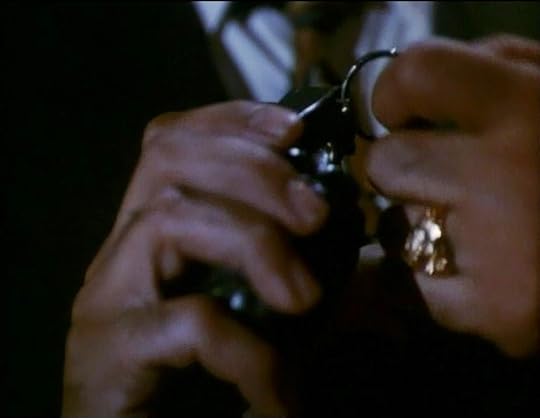
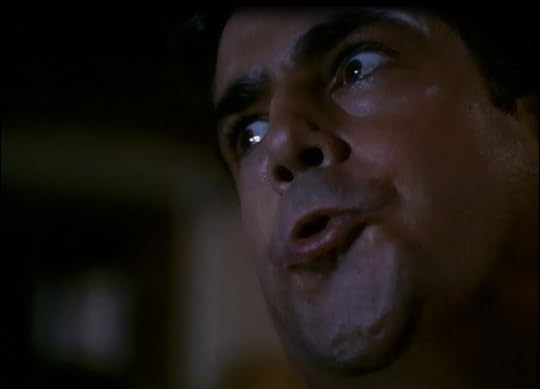
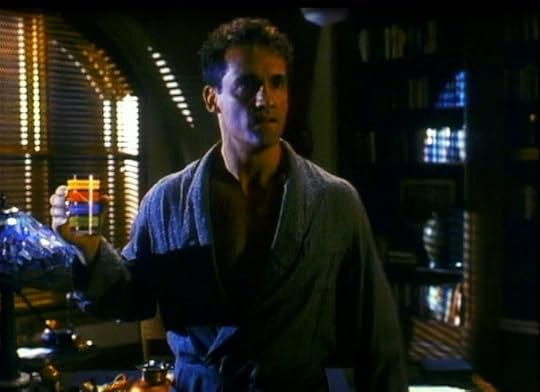
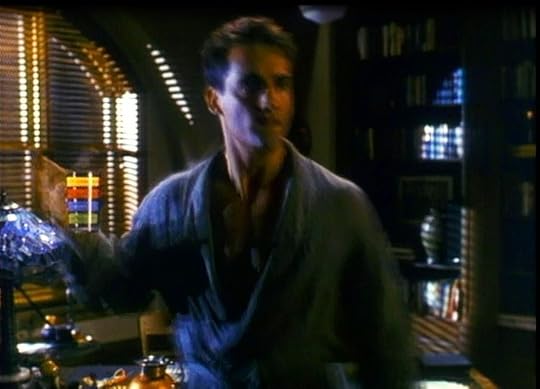
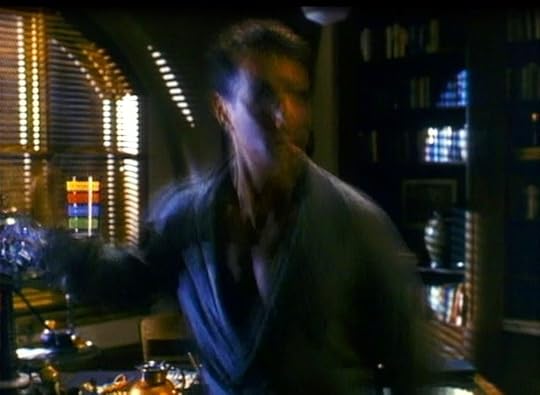
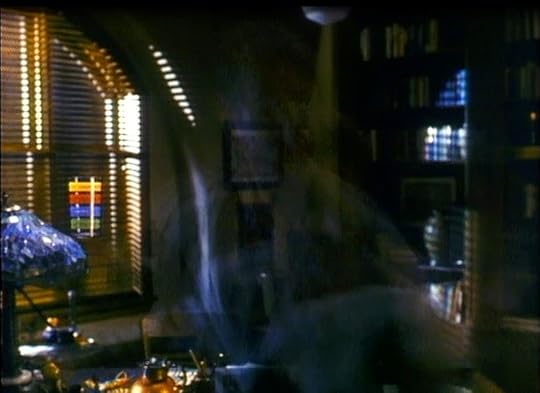
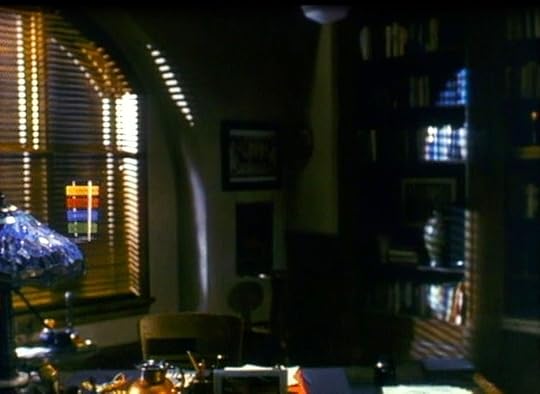
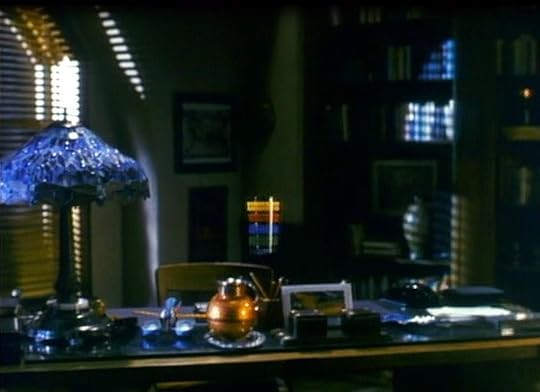
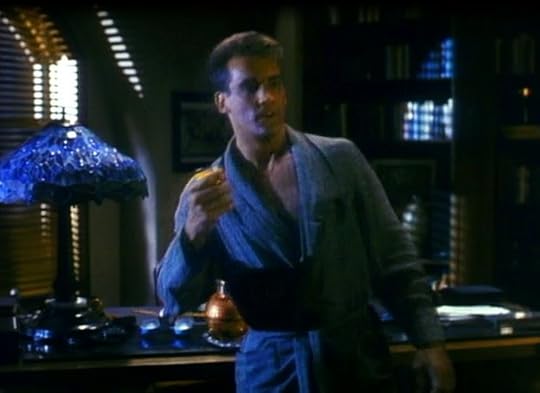
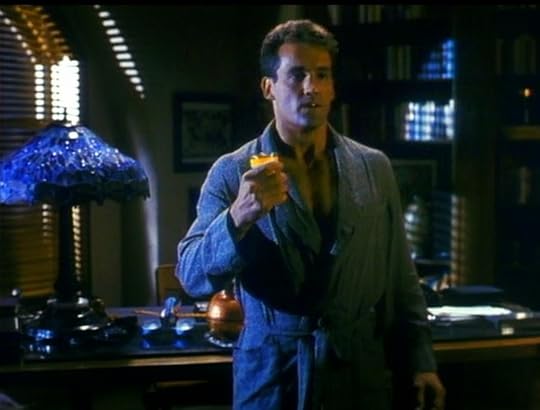
“Honor Among Thieves” contains an inadvertent nod to the future Dynamic Duo of the CW: Flash and Arrow.
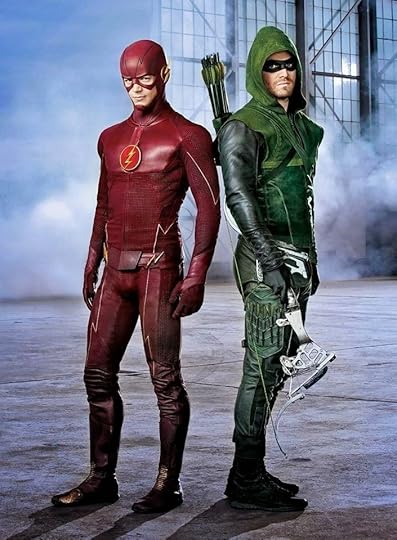
In the climactic scene, the Flash uses a bow and arrow to trap a villain.
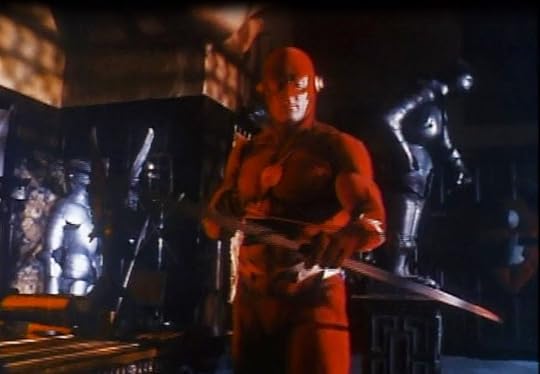
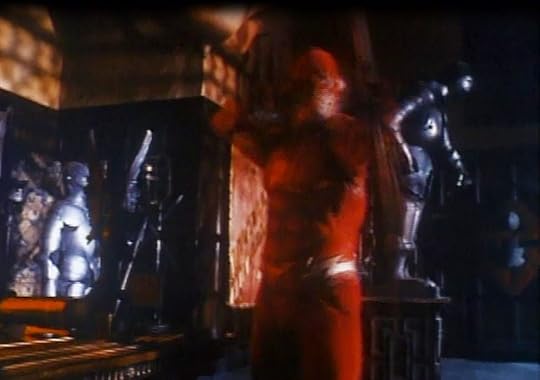
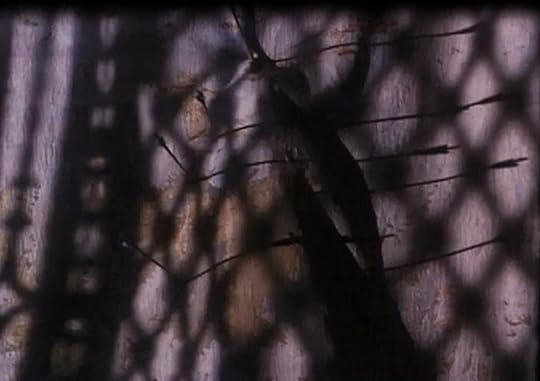
(Another Arrow connection: on Flash ‘90, David Cassidy played Mirror Master; his daughter Katie plays Laurel Lance on Arrow.)
In “Double Vision,” a flashily-dressed pimp(like) character, upon seeing the Flash for the first time, says “Hey! Red Suit! One cool drag, man!” This sure feels like a reference to a classic moment in Superman: The Movie (1978) in which a flashily-dressed pimp character, upon seeing Superman for the first time, says, “Say, Jim…woo! That’s a bad outfit! Woo!”
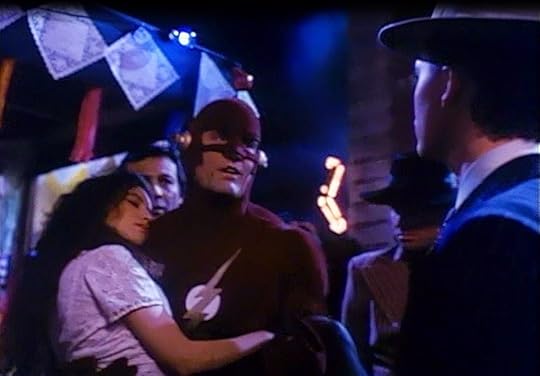
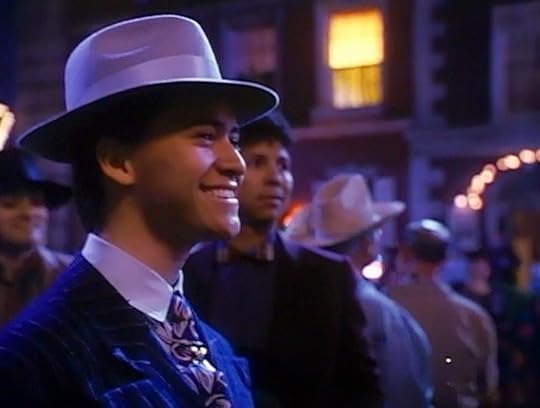
Speaking of Superman, part 2: In “Child’s Play,” in a scene I vividly remembered from 25 years ago, Barry walks is dog past a movie theater showing a particularly apt double feature (which presumably situates Barry in a world where his usual comrades are fictional):
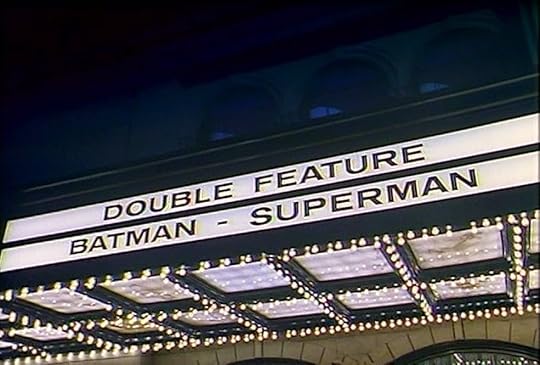
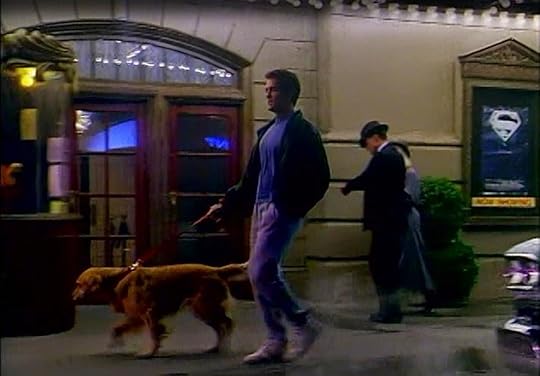
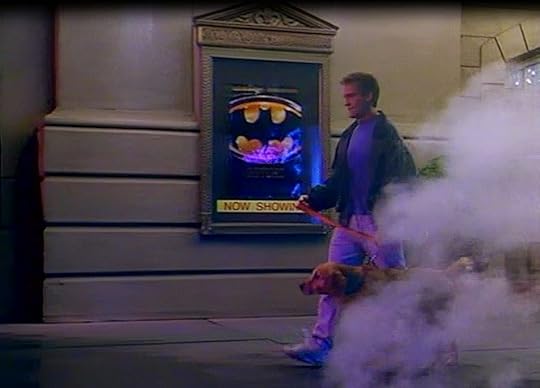
When his dog tries to go into the theater, Barry says “Hey, don’t we get enough of that?”
Speaking of Superman, part 3: In “Captain Cold,” Barry jokingly refers to a pushy female reporter as “Lois Lane.”
In “Ghost in the Machine,” Nightshade, a hero who was active in the 1950s and had since retired, cautions Barry, “Thirty-five years from now, who will remember the Flash?” It struck a chord then, in those pre-Internet days. It’s funny now in a meta way: 25 years after the show and that line, the Flash has been revived on TV. This series will definitely last longer than one season. Maybe not ten seasons, proving Nightshade’s “35 years” prophecy wrong, but this Flash shows no signs of slowing down.
Nightshade also says Barry hadn’t heard of him because world was not on “video” during his mask-wearing years. Quaint as that is, the same episode also refers to “data networks,” “online,” and (to my great surprise) “the net,” which even four years later was still a mystery to many.
In “Fast Forward,” they flash a Flash figure, from the 1984 Super Powers line. At the time, it was the only Flash action figure that had been produced.
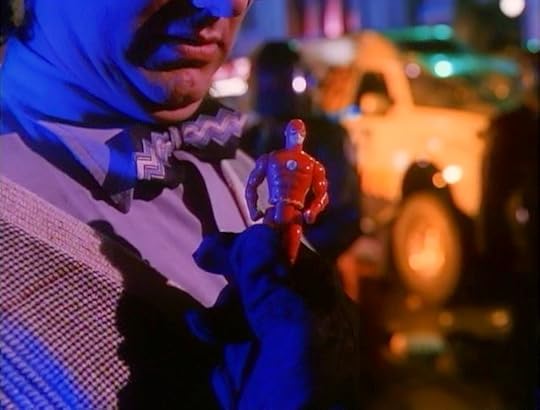
Similar to Frankie Thorn appearing “Watching the Detectives,” another woman from my “girl in the video” series also guested on Flash (in “Done With Mirrors”): Signy Coleman, from two Huey Lewis and the News videos.
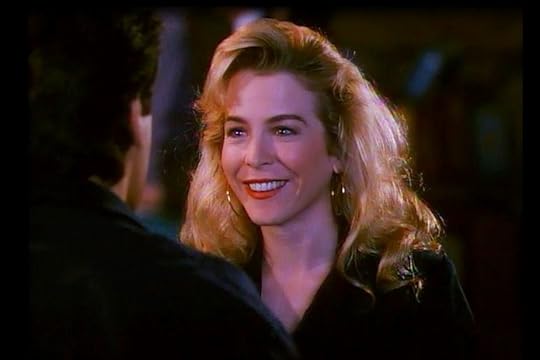
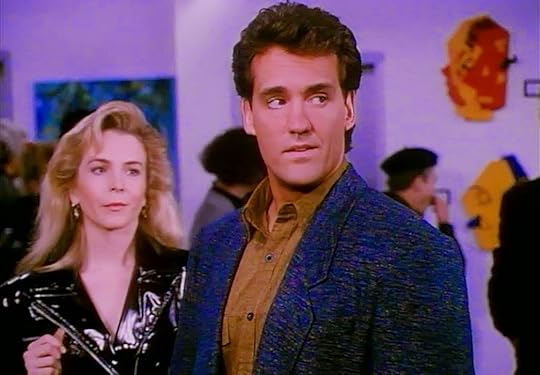
In the series finale (which, in those days, was not marketed as the “series finale”), the Trickster returns and acquires a sidekick named Prank.
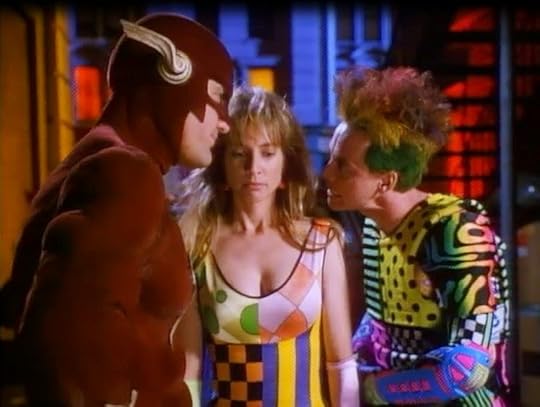
This episode aired in May 1991. In September 1992, on Batman: The Animated Series, Harley Quinn debuted. She was a sexy, crazy, female criminal who was obsessed with the Joker…just as Prank was a sexy, crazy, female criminal obsessed with the Trickster. What makes this worth pointing out is that both the Trickster and the Joker were played by Mark Hamill.
Only a week after Flash ‘14 premiered, Warner Bros. announced a significant five-year slate of movies based on DC Comics superheroes, including the Flash. He will be played by Ezra Miller, which made waves for two reasons: one, Ezra Miller is not Grant Gustin, who had just started in the role and two, Barry Allen (nor any of the other Flashes in comics) is not gay but Miller is. (This was not a controversy, merely a conversation point.)
However, Miller is not the first openly gay actor to play a straight superhero. In fact, he’s not even the first openly gay actor to play the Flash. Though private about his private life, including his sexuality, John Wesley Shipp (according to numerous reports) is gay.
About the time Flash ‘90 aired, I began collecting various series of magazine advertisements, including the then-famous Absolut Vodka campaign. (I wasn’t a drinker but I liked some of the ads.)
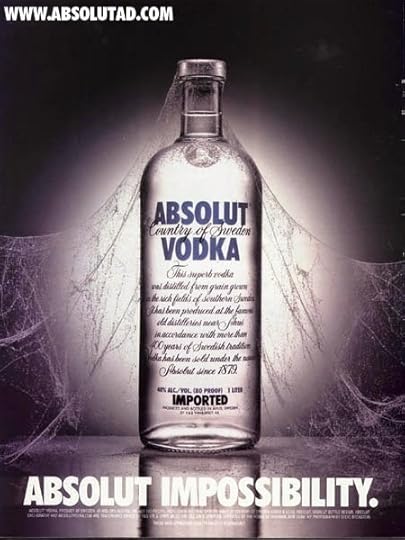
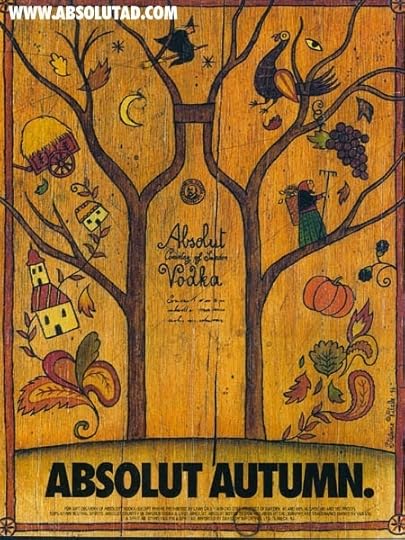
My friend Traci, who had a TV and generously let me watch Flash in her room, made me this (with an assist from her roommate Lauren):
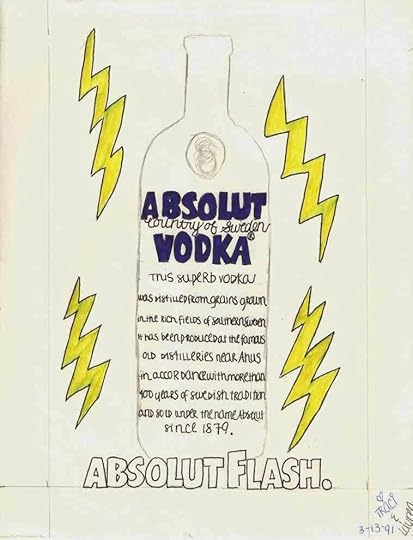
And four years later, my Flash fixation (Flashation?) was still present enough that the graduation gifts my good friends Justin and his tolerant girlfriend-now-wife Deb bought me were all Flash-related:
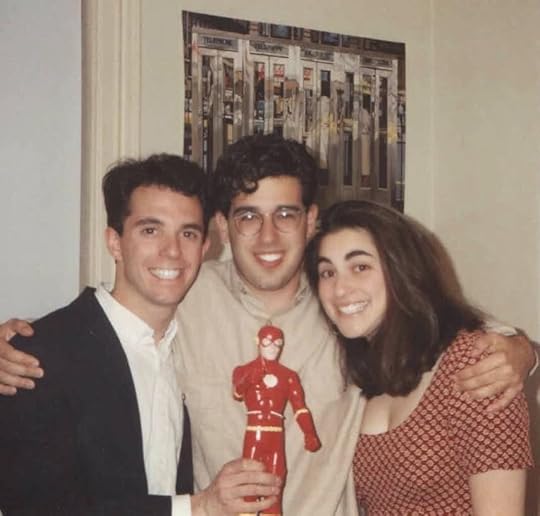
I still have that figurine.
In sum, I loved Flash ‘90 then, and still love it now. I really like Flash ‘14 now, and I don’t have a Cosmic Treadmill to verify this, but I think I’ll still like it in 2038.
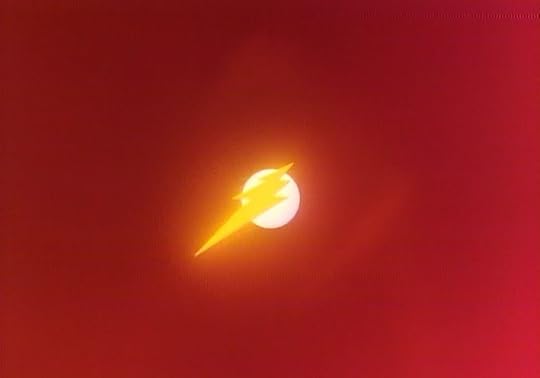
My freshman year of college, I had a subscription to TV Guide but no TV. No matter, because there was only one show I wouldn’t miss: The Flash on CBS.


I remember finding it funny how TV Guide had to reword the marketing of its original ad when it reran the premiere:


This was a year after Tim Burton’s juggernaut Batman, and its aesthetic was forced on the Flash, a character who had never been grim—in fact quite the opposite. So the show struck a divided tone—gritty, often dark Flash sequences, cheeky and at times cheesy Barry Allen scenes. (Part of the cheese was simply a symptom of the times—it was the fashion era of baggy pants. Please Allen, don’t hurt ‘em.)

I loved how the Flash pilot copied Batman with a scene in which something (the Batwing in Batman, a bolt of lightning in Flash) turned the moon into the emblem of the title hero:




The show was canceled after one season, though the factors were cost and competition more than quality...this TV Guide review aside:

My commitment to this show began with a commitment to the character who, as it happens, had “died” five years earlier. In the landmark 1985 comic book maxi-series Crisis on Infinite Earths, Barry Allen nobly sacrificed himself to save multiple worlds. In comics, deaths are typically temporary, but this one would last a notable 23 years.
So in 1990, Barry Allen was a memory in print but a, well, flash of fresh air on TV. He was the first live-action DC hero whose show felt like a movie rather than a TV show (see Superboy, Wonder Woman, Batman).
It turned out that the original pitch for the show that became The Flash was called Unlimited Powers and featured four heroes. It would have been an eclectic assortment with no comic book precedent: the Flash, Green Arrow’s daughter, Dr. Occult, and Blok (from the Legion of Super-Heroes). Deemed too expensive if not too odd, the Flash (as he does) broke away from the pack and the other three characters were ditched.


It was a thrill when, in 2009, I reached out to its star, John Wesley Shipp, on Facebook, and he reached back. He seems every bit as cool in real life as his character was on the show.
The Flash, for all intents, was a two-actor show: Shipp and Amanda Pays as scientist/friend/guide/inevitable love interest Tina McGee. A third actor, Alex Desert, was included in the opening credits, and others (mostly cops) recurred in small roles, but most of the show revolved around Barry and Tina. (A 2009 interview with both actors at a con—the first one Pays attended.) In the current TV incarnation of the Flash, his behind-the-scenes team (Harrison Wells, Caitlin Snow, and Cisco Ramon) alone is bigger than that. Castwise, The Flash ‘90 seems so simple in our era of shows with, commonly, at least six regulars who appear roughly equally.
Flash ‘90 is the first filmed DC entertainment with an “Oracle” figure. Oracle herself (Barbara Gordon as information broker/Big Sister Is Watching, after the Joker crippled her in a 1988 story) debuted in 1989, a year before The Flash. Tina was that show’s Oracle, and a variation of her has since appeared in Smallville (Chloe Sullivan), Arrow (Felicity Smoak), and Flash ‘14 (Caitlin Show). All are tech guru-esses, all have some degree of romantic chemistry with the lead hero.
Tina McGee made her debut appearance on Flash ‘14 in the “mid-season finale” (a transparently manipulative term/concept that, of course, didn’t exist in 1990). This was especially interesting because Tina was again played by Amanda Pays—but it was not the same Tina from the previous show. It couldn’t be—she knew Barry Allen, and Grant Gustin is no John Wesley Shipp. (I mean that literally—not as a dig.)
Is this the first instance of the same actor portraying two versions of the same character? It’s definitely the first instance of one actor portraying a character of the same name on two separate shows of the same name…followed closely by Mark Hamill as the Trickster, which was announced 12/8/14, the day before the mid-season finale. (The day after would have made more sense to me.)
Flash ‘90 was an attempt—now ubiquitous—to do filmed superheroes “realistically.” A prime example: no spandex. The way the show explained why Barry wore a costume—and where the costume came from—both struck me as pretty close to realistic, or at least believable. He wore a costume (and specifically requested that it have a mask and gloves) to protect his identity when seeking revenge—or justice—for the murder of his brother. The costume was a prototype developed for cosmonauts (red, get it?), designed to withstand pressure and friction.
While most everyone is binge-watching critically acclaimed contemporary shows such as Homeland, Game of Thrones, and Orange Is the New Black, I’m reverse-flashing to Maroon Is the New Red.
Episode-specific observations (some I recalled from original viewing, some new):
“Watching the Detectives” features a cameo by Frankie Thorn, whom I interviewed for her appearance in the “We Didn’t Start the Fire” video by Billy Joel, though at the time, I did not know/remember she had been in that Flash episode. (See below for a similar discovery in “Done With Mirrors.”)


In the same episode, Tina name-drops Carter Hall…AKA Hawkman. As far as I know, that was the only time, and he never appeared in the flesh.
Also in the same episode is what might be my all-time favorite scene from the series, in which a crooked DA, who used a shady method to learn the Flash’s secret identity, tries to bribe Barry. When Barry plays dumb, the DA threatens him with an armed grenade. The DA says “In your short career, you’ve already made enemies in all the wrong places, Barry. If your identity was made public, everyone you love would be in danger from everything in Central City. Your family, your friends, your dog…here boy! Fetch! Four-second fuse. Three…two…”
I don’t believe the scene is on YouTube so here are screenshots showing how Barry let go of a glass, flashed to the grenade, reinserted the pin (which, I believe, would not really stop the grenade from exploding), set the grenade on his desk, and caught the glass, which had fallen only an inch or two:











“Honor Among Thieves” contains an inadvertent nod to the future Dynamic Duo of the CW: Flash and Arrow.

In the climactic scene, the Flash uses a bow and arrow to trap a villain.



(Another Arrow connection: on Flash ‘90, David Cassidy played Mirror Master; his daughter Katie plays Laurel Lance on Arrow.)
In “Double Vision,” a flashily-dressed pimp(like) character, upon seeing the Flash for the first time, says “Hey! Red Suit! One cool drag, man!” This sure feels like a reference to a classic moment in Superman: The Movie (1978) in which a flashily-dressed pimp character, upon seeing Superman for the first time, says, “Say, Jim…woo! That’s a bad outfit! Woo!”


Speaking of Superman, part 2: In “Child’s Play,” in a scene I vividly remembered from 25 years ago, Barry walks is dog past a movie theater showing a particularly apt double feature (which presumably situates Barry in a world where his usual comrades are fictional):



When his dog tries to go into the theater, Barry says “Hey, don’t we get enough of that?”
Speaking of Superman, part 3: In “Captain Cold,” Barry jokingly refers to a pushy female reporter as “Lois Lane.”
In “Ghost in the Machine,” Nightshade, a hero who was active in the 1950s and had since retired, cautions Barry, “Thirty-five years from now, who will remember the Flash?” It struck a chord then, in those pre-Internet days. It’s funny now in a meta way: 25 years after the show and that line, the Flash has been revived on TV. This series will definitely last longer than one season. Maybe not ten seasons, proving Nightshade’s “35 years” prophecy wrong, but this Flash shows no signs of slowing down.
Nightshade also says Barry hadn’t heard of him because world was not on “video” during his mask-wearing years. Quaint as that is, the same episode also refers to “data networks,” “online,” and (to my great surprise) “the net,” which even four years later was still a mystery to many.
In “Fast Forward,” they flash a Flash figure, from the 1984 Super Powers line. At the time, it was the only Flash action figure that had been produced.

Similar to Frankie Thorn appearing “Watching the Detectives,” another woman from my “girl in the video” series also guested on Flash (in “Done With Mirrors”): Signy Coleman, from two Huey Lewis and the News videos.


In the series finale (which, in those days, was not marketed as the “series finale”), the Trickster returns and acquires a sidekick named Prank.

This episode aired in May 1991. In September 1992, on Batman: The Animated Series, Harley Quinn debuted. She was a sexy, crazy, female criminal who was obsessed with the Joker…just as Prank was a sexy, crazy, female criminal obsessed with the Trickster. What makes this worth pointing out is that both the Trickster and the Joker were played by Mark Hamill.
Only a week after Flash ‘14 premiered, Warner Bros. announced a significant five-year slate of movies based on DC Comics superheroes, including the Flash. He will be played by Ezra Miller, which made waves for two reasons: one, Ezra Miller is not Grant Gustin, who had just started in the role and two, Barry Allen (nor any of the other Flashes in comics) is not gay but Miller is. (This was not a controversy, merely a conversation point.)
However, Miller is not the first openly gay actor to play a straight superhero. In fact, he’s not even the first openly gay actor to play the Flash. Though private about his private life, including his sexuality, John Wesley Shipp (according to numerous reports) is gay.
About the time Flash ‘90 aired, I began collecting various series of magazine advertisements, including the then-famous Absolut Vodka campaign. (I wasn’t a drinker but I liked some of the ads.)


My friend Traci, who had a TV and generously let me watch Flash in her room, made me this (with an assist from her roommate Lauren):

And four years later, my Flash fixation (Flashation?) was still present enough that the graduation gifts my good friends Justin and his tolerant girlfriend-now-wife Deb bought me were all Flash-related:

I still have that figurine.
In sum, I loved Flash ‘90 then, and still love it now. I really like Flash ‘14 now, and I don’t have a Cosmic Treadmill to verify this, but I think I’ll still like it in 2038.

Published on January 20, 2015 04:00
January 18, 2015
Interview about Bill Finger in “Alter Ego” #130
One of the first resources I checked when I began my research on Bill Finger (as well as Jerry Siegel and Joe Shuster) was the comics history magazine Alter Ego. Full circle: an interview with me about Bill Finger is in Alter Ego #130 (1/15).
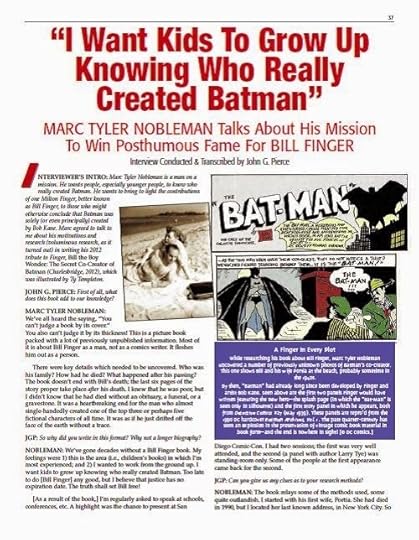
Thank you again, Roy, for running it, and John, for conducting it.

Thank you again, Roy, for running it, and John, for conducting it.
Published on January 18, 2015 04:00
January 12, 2015
When superheroes vote
In 1983, the Flash killed the Reverse-Flash. Then the Justice League of America voted on whether or not to kick Flash out. (The cover gave away everything but the deciding vote.)
Here are the results of that show of thumbs and five others involving DC Comics characters. (As it happens, in multiple instances, the number of members voting was seven.)
The Flash #327 (11/83)
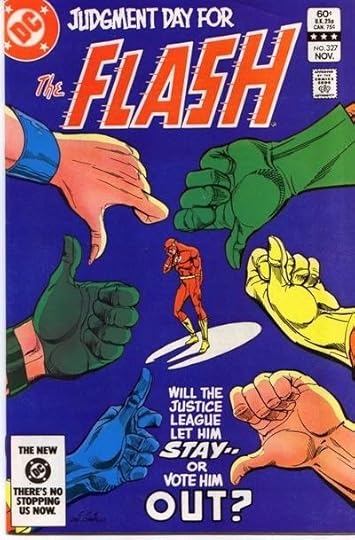
in:
Green Arrow
Elongated Man
Firestorm
out:
Wonder Woman
Aquaman
Hawkman
tiebreaker (in):
Superman
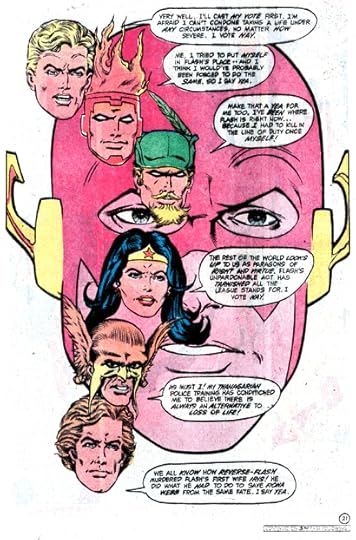
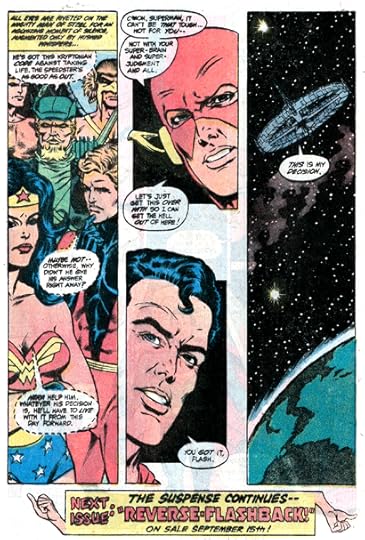
JLA: The Secret Society of Super-Heroes #2 (2000)
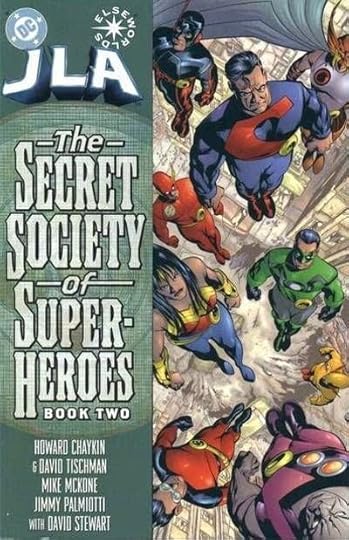
The issue: Should the group go public?
(vote not formally revealed but implied by composition)
go public:
Flash
Green Lantern
Atom
Plastic Man
stay hidden:
Superman
Wonder Woman
Hawkgirl
Metamorpho
tiebreaker (go public):
Impulse/Kid Flash
JLA #46 (10/00)
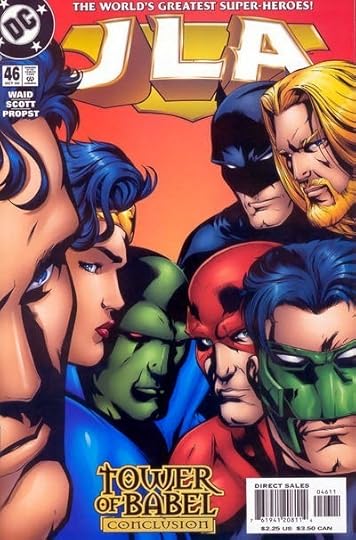
The issue: Should Batman be kicked out of the JLA for preparing methods of stopping JLA members should they go rogue?
in:
Flash
Green Lantern
Martian Manhunter
out:
Wonder Woman
Aquaman
Plastic Man
tiebreaker (out):
Superman
Justice League season 2/series finale “Starcrossed” (5/04)
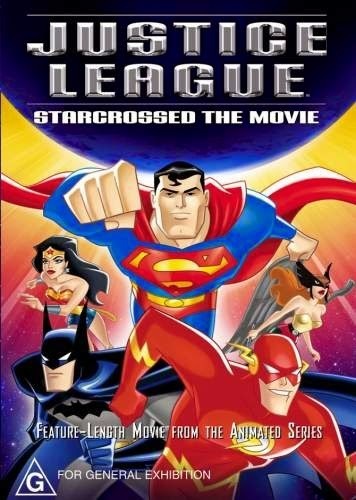
The issue: Should Hawkgirl be kicked out of the Justice League for originally joining the League as a Thanagarian advance scout/spy?
(vote not shown but this is how it was later revealed to go)
in:
Flash
Martian Manhunter
out:
Batman
Wonder Woman
recused:
Green Lantern
tiebreaker (in):
Superman (stated in the subsequent episode “Wake the Dead”)
Identity Crisis #2 (9/04)
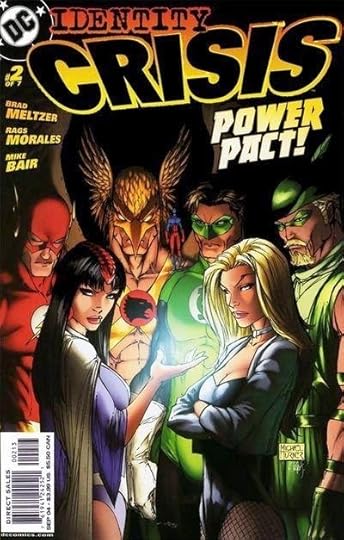
The issue: Should the JLA mindwipe (“clean up”) Dr. Light for threatening to attack Sue Dibny again?
for:
Hawkman
Atom
Zatanna
against:
Green Lantern
Green Arrow
Black Canary
tiebreaker (for):
Flash
JLA #118 (11/05)
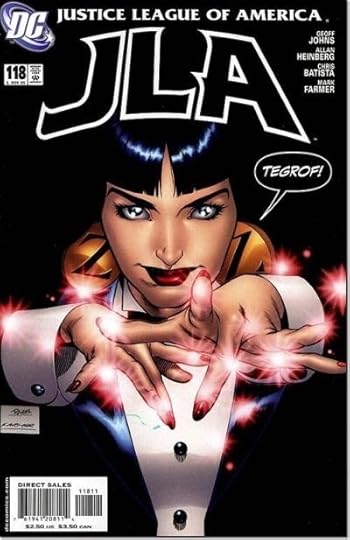
The issue: Should the JLA mindwipe (“clean up”) members of the Secret Society of Super-Villains who learned the JLA’s secret identities?
for:
Flash
Hawkman
Green Arrow
against:
Superman
Green Lantern
Black Canary
tiebreaker (she wouldn’t do the mindwipe so a no):
Zatanna
Superman was a tiebreaker three times, twice siding with teammates (Flash and Hawkgirl) and once siding against (Batman).
The harshest voters?
Wonder Woman voted against a teammate three times, Aquaman twice. Hawkman voted against a teammate once and twice voted to mindwipe villains. Twice Flash voted to keep a teammate but twice he voted to mindwipe.
The most sympathetic voters?
Like Flash, Martian Manhunter twice voted to keep a teammate. (He was not present for mindwipe votes.)Green Lantern voted to keep a teammate and twice voted not to mindwipe.Black Canary twice voted not to mindwipe.Green Arrow voted to keep a teammate; he voted once to mindwipe and once not to.
Am I missing any DC Comics voting scenarios?
Here are the results of that show of thumbs and five others involving DC Comics characters. (As it happens, in multiple instances, the number of members voting was seven.)
The Flash #327 (11/83)

in:
Green Arrow
Elongated Man
Firestorm
out:
Wonder Woman
Aquaman
Hawkman
tiebreaker (in):
Superman


JLA: The Secret Society of Super-Heroes #2 (2000)

The issue: Should the group go public?
(vote not formally revealed but implied by composition)
go public:
Flash
Green Lantern
Atom
Plastic Man
stay hidden:
Superman
Wonder Woman
Hawkgirl
Metamorpho
tiebreaker (go public):
Impulse/Kid Flash
JLA #46 (10/00)

The issue: Should Batman be kicked out of the JLA for preparing methods of stopping JLA members should they go rogue?
in:
Flash
Green Lantern
Martian Manhunter
out:
Wonder Woman
Aquaman
Plastic Man
tiebreaker (out):
Superman
Justice League season 2/series finale “Starcrossed” (5/04)

The issue: Should Hawkgirl be kicked out of the Justice League for originally joining the League as a Thanagarian advance scout/spy?
(vote not shown but this is how it was later revealed to go)
in:
Flash
Martian Manhunter
out:
Batman
Wonder Woman
recused:
Green Lantern
tiebreaker (in):
Superman (stated in the subsequent episode “Wake the Dead”)
Identity Crisis #2 (9/04)

The issue: Should the JLA mindwipe (“clean up”) Dr. Light for threatening to attack Sue Dibny again?
for:
Hawkman
Atom
Zatanna
against:
Green Lantern
Green Arrow
Black Canary
tiebreaker (for):
Flash
JLA #118 (11/05)

The issue: Should the JLA mindwipe (“clean up”) members of the Secret Society of Super-Villains who learned the JLA’s secret identities?
for:
Flash
Hawkman
Green Arrow
against:
Superman
Green Lantern
Black Canary
tiebreaker (she wouldn’t do the mindwipe so a no):
Zatanna
Superman was a tiebreaker three times, twice siding with teammates (Flash and Hawkgirl) and once siding against (Batman).
The harshest voters?
Wonder Woman voted against a teammate three times, Aquaman twice. Hawkman voted against a teammate once and twice voted to mindwipe villains. Twice Flash voted to keep a teammate but twice he voted to mindwipe.
The most sympathetic voters?
Like Flash, Martian Manhunter twice voted to keep a teammate. (He was not present for mindwipe votes.)Green Lantern voted to keep a teammate and twice voted not to mindwipe.Black Canary twice voted not to mindwipe.Green Arrow voted to keep a teammate; he voted once to mindwipe and once not to.
Am I missing any DC Comics voting scenarios?
Published on January 12, 2015 04:00
December 31, 2014
Pop culture interview grab bag
This blog has run an eclectic range of interviews; the subjects relate to publishing, superheroes, and other aspects of pop culture. I will continually add to this list.
publishing
Actress Ally Sheedy, who published She Was Nice to Mice, a book for children, when she was a child herself.The author of David and the Phoenix, a cult favorite middle grade novel from the ‘50s.The author/illustrator of Little Gorilla, a classic picture book from the ‘70s.The creator/artist of the successful Anti-Coloring Book series. The creators of Stone Soup, the long-running literary magazine written and drawn exclusively by young people.The woman who, in 1989, portrayed Sarah Morton for a Scholastic book on Pilgrim life.
superheroes
The granddaughter of the creator of Wonder Woman.The singer of the 1981 hit song “Theme from The Greatest American Hero (Believe It or Not).” The grandson of a man who may have visually inspired Clark Kent. The lead singer of the theme song of the first season of the 1970s Wonder Woman show. The first (known) person to play Bill Finger in a production (in this case, a play).The two men who broke the story of Superman’s co-creators living in poverty and obscurity.Almost a dozen now-deceased writers/artists from the Golden/Silver Age of Comics.The man who convinced the comics community that there would be a Wonder Twins movie. publishing + superheroes
The brother and representative of the late author of the critically-praised 1979 YA novel The Kryptonite Kid.The man who wrote Bob Kane’s autobiography. (No, it wasn’t Bob Kane.)
other pop culture
Dozens of ‘80s music video ingénues. Round 2.Scores of ‘70s and ‘80s superhero performers.Songwriters and singers of Schoolhouse Rock .Voice actors of Peanuts TV holiday specials. The kids from the opening flashback scene of Splash. The cast of “The Bloodhound Gang” detective segment from 3-2-1 Contact.
plus
A mother who runs a playroom that is also a nonfiction library.A teacher who is also a ghost hunter.
publishing
Actress Ally Sheedy, who published She Was Nice to Mice, a book for children, when she was a child herself.The author of David and the Phoenix, a cult favorite middle grade novel from the ‘50s.The author/illustrator of Little Gorilla, a classic picture book from the ‘70s.The creator/artist of the successful Anti-Coloring Book series. The creators of Stone Soup, the long-running literary magazine written and drawn exclusively by young people.The woman who, in 1989, portrayed Sarah Morton for a Scholastic book on Pilgrim life.
superheroes
The granddaughter of the creator of Wonder Woman.The singer of the 1981 hit song “Theme from The Greatest American Hero (Believe It or Not).” The grandson of a man who may have visually inspired Clark Kent. The lead singer of the theme song of the first season of the 1970s Wonder Woman show. The first (known) person to play Bill Finger in a production (in this case, a play).The two men who broke the story of Superman’s co-creators living in poverty and obscurity.Almost a dozen now-deceased writers/artists from the Golden/Silver Age of Comics.The man who convinced the comics community that there would be a Wonder Twins movie. publishing + superheroes
The brother and representative of the late author of the critically-praised 1979 YA novel The Kryptonite Kid.The man who wrote Bob Kane’s autobiography. (No, it wasn’t Bob Kane.)
other pop culture
Dozens of ‘80s music video ingénues. Round 2.Scores of ‘70s and ‘80s superhero performers.Songwriters and singers of Schoolhouse Rock .Voice actors of Peanuts TV holiday specials. The kids from the opening flashback scene of Splash. The cast of “The Bloodhound Gang” detective segment from 3-2-1 Contact.
plus
A mother who runs a playroom that is also a nonfiction library.A teacher who is also a ghost hunter.
Published on December 31, 2014 04:00
December 15, 2014
“Batman ’66: The Lost Episode” and Bill Finger
Legendary Batman (and the Outsiders) writer/Bill Finger advocate Mike W. Barr wrote in with an interesting observation:
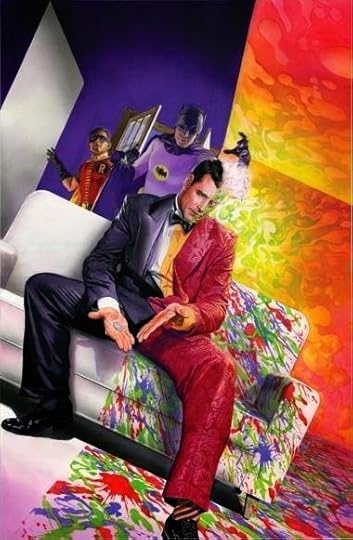
Mike also noted that this story has been reprinted in the following:
Batman Annual #3 (1961)Batman From the Thirties to the Seventies (Crown, 10/71)DC Comics Classic Library: The Batman Annuals (DC, 4/09)
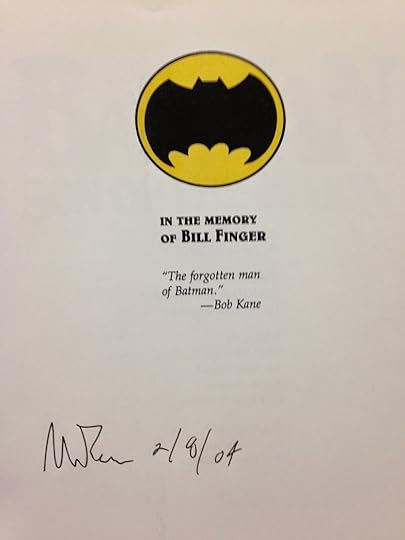 from Son of the Demon, written by Mike;too bad Bob is not here to see that Billis no longer forgotten...too bad Bill is not,either...
from Son of the Demon, written by Mike;too bad Bob is not here to see that Billis no longer forgotten...too bad Bill is not,either...
Thank you to Michael Savene for the scan.
At least the climax of the recently published Batman ’66: The Lost Episode—adapting a Two-Face story from a treatment by Harlan Ellison in which Batman compels Two-Face to surrender by substituting a flawed duplicate of Two-Face’s lucky coin—was foreshadowed by Finger’s script to “The New Crimes of Two-Face!” from Batman #68 (12/51-1/52), in which Batman defeats Two-Face by exactly the same method.

Mike also noted that this story has been reprinted in the following:
Batman Annual #3 (1961)Batman From the Thirties to the Seventies (Crown, 10/71)DC Comics Classic Library: The Batman Annuals (DC, 4/09)
 from Son of the Demon, written by Mike;too bad Bob is not here to see that Billis no longer forgotten...too bad Bill is not,either...
from Son of the Demon, written by Mike;too bad Bob is not here to see that Billis no longer forgotten...too bad Bill is not,either... Thank you to Michael Savene for the scan.
Published on December 15, 2014 05:49
December 12, 2014
"Rolling Stone" links to my "If This Is It" interviews
In 9/14, Rolling Stone counted down the best singles of 1984.
Number 49 is "If This Is It" by Huey Lewis and the News.
And the write-up links (the word "report") to my interview with the two women in the video:

Number 49 is "If This Is It" by Huey Lewis and the News.
And the write-up links (the word "report") to my interview with the two women in the video:

Published on December 12, 2014 04:00
December 8, 2014
Trivial Pursuit perpetuates the Nazis-banned-Superman myth
In 2008, both in Boys of Steel: The Creators of Superman and here, I addressed the recurring claim that Hitler or his Minister of Propaganda Joseph Goebbels personally indicted and banned Superman at a Nazi meeting.
It turns up in sources including Superman at Fifty (1988; page 32), Men of Tomorrow by Gerard Jones (2004; page 162), and Jerry Robinson’s essay in the Breman Jewish Heritage Museum exhibition catalog Zap! Pow! Bam! The Superhero—The Golden Age of Comic Books 1938-1950 (2004; page 21).
However, the Nazis were famously fanatical about documentation and we haven’t found mention of this incident in their—or any other—records. So believable though it may be, there is no known proof that it really happened. Researchers including Dwight Decker determined a likely source of what we must consider a myth.
I learned recently that Trivial Pursuit (Genus 5 edition) isn’t helping:
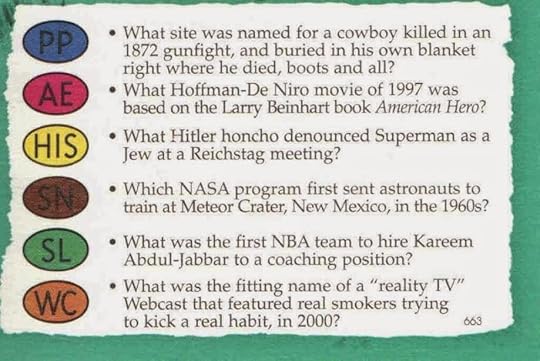
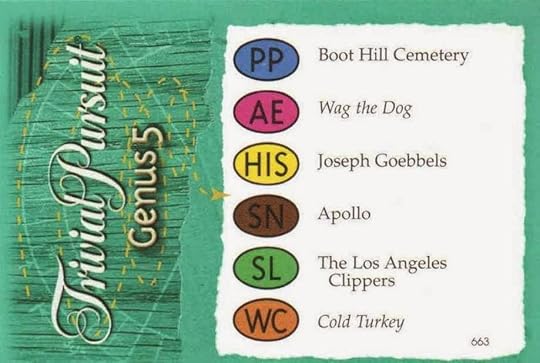
It turns up in sources including Superman at Fifty (1988; page 32), Men of Tomorrow by Gerard Jones (2004; page 162), and Jerry Robinson’s essay in the Breman Jewish Heritage Museum exhibition catalog Zap! Pow! Bam! The Superhero—The Golden Age of Comic Books 1938-1950 (2004; page 21).
However, the Nazis were famously fanatical about documentation and we haven’t found mention of this incident in their—or any other—records. So believable though it may be, there is no known proof that it really happened. Researchers including Dwight Decker determined a likely source of what we must consider a myth.
I learned recently that Trivial Pursuit (Genus 5 edition) isn’t helping:


Published on December 08, 2014 04:00
December 5, 2014
Student research challenge: find the oldest house on your street
Teachers tend to love when authors who visit their schools excite students about research. It’s one thing to say research is adventure and quite another to show that…but it’s not always easy for teachers to come up with effective, age-suitable examples.
My school visit presentations emphasize the thrill of primary research, focusing on the detective work I did to write Boys of Steel: The Creators of Superman and Bill the Boy Wonder: The Secret Co-Creator of Batman. This involved everything from tracking down Bill Finger’s son Fred’s 1992 settlement of estate document at a New York surrogate’s court to cold-calling everyone in Florida with the last name “Finger”—not the kind of things most elementary students can or should be doing.
So how to make primary research accessible to young people?
Doing is believing, so I suggest challenging them to determine which house or building on their street is the oldest. It’s localized and limited (well, depending on how long any particular street is), so in most cases, it’s an assignment that young researchers can embrace. A street’s oldest house is not information a Google search will provide, so it will require them to think creatively. How else can they find out the answer?
Teachers, if you put this challenge to your students, please let me know in the comments. I’d love to hear some stories.
My school visit presentations emphasize the thrill of primary research, focusing on the detective work I did to write Boys of Steel: The Creators of Superman and Bill the Boy Wonder: The Secret Co-Creator of Batman. This involved everything from tracking down Bill Finger’s son Fred’s 1992 settlement of estate document at a New York surrogate’s court to cold-calling everyone in Florida with the last name “Finger”—not the kind of things most elementary students can or should be doing.
So how to make primary research accessible to young people?
Doing is believing, so I suggest challenging them to determine which house or building on their street is the oldest. It’s localized and limited (well, depending on how long any particular street is), so in most cases, it’s an assignment that young researchers can embrace. A street’s oldest house is not information a Google search will provide, so it will require them to think creatively. How else can they find out the answer?
Teachers, if you put this challenge to your students, please let me know in the comments. I’d love to hear some stories.
Published on December 05, 2014 04:00



